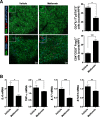Metformin improves salivary gland inflammation and hypofunction in murine Sjögren's syndrome
- PMID: 31164166
- PMCID: PMC6549273
- DOI: 10.1186/s13075-019-1904-0
Metformin improves salivary gland inflammation and hypofunction in murine Sjögren's syndrome
Abstract
Background: Activated T and B cells participate in the development and progression of Sjögren's syndrome (SS). Metformin, a first-line anti-diabetic drug, exerts anti-inflammatory and immunomodulatory effects by activating AMPK. We investigated the therapeutic effect of metformin in non-obese diabetic (NOD)/ShiLtJ mice, an animal model of SS.
Methods: Metformin or vehicle was administered orally to the mice for 9 weeks. The salivary flow rate was measured at 11, 13, 15, 17, and 20 weeks. Histological analysis of the salivary glands from vehicle- and metformin-treated mice was conducted. CD4+ T and B cell differentiation in the peripheral blood and/or spleen was determined by flow cytometry. Serum total IgG, IgG1, and IgG2a levels were determined by enzyme-linked immunosorbent assay.
Results: Metformin reduced salivary gland inflammation and restored the salivary flow rate. Moreover, metformin reduced the interleukin (IL)-6, tumor necrosis factor-α, IL-17 mRNA, and protein levels in the salivary glands. Metformin reduced the Th17 and Th1 cell populations and increased the regulatory T cell population in the peripheral blood and spleen and modulated the balance between Tfh and follicular regulatory T cells. In addition, metformin reduced B cell differentiation into germinal center B cells, decreased the serum immunoglobulin G level, and maintained the balance between IL-10- and IL-17-producing B cells.
Conclusion: Metformin suppresses effector T cells, induces regulatory T cells, and regulates B cell differentiation in an animal model of SS. In addition, metformin ameliorates salivary gland inflammation and hypofunction, suggesting that it has potential for the treatment of SS.
Keywords: AMP-activated protein kinase; B-lymphocyte; Metformin; STAT3; Sjögren’s syndrome; TOR serine-threonine kinase; Th17 cells.
Conflict of interest statement
The authors declare that they have no competing interests.
Figures






References
Publication types
MeSH terms
Substances
Grants and funding
LinkOut - more resources
Full Text Sources
Medical
Research Materials
Miscellaneous

